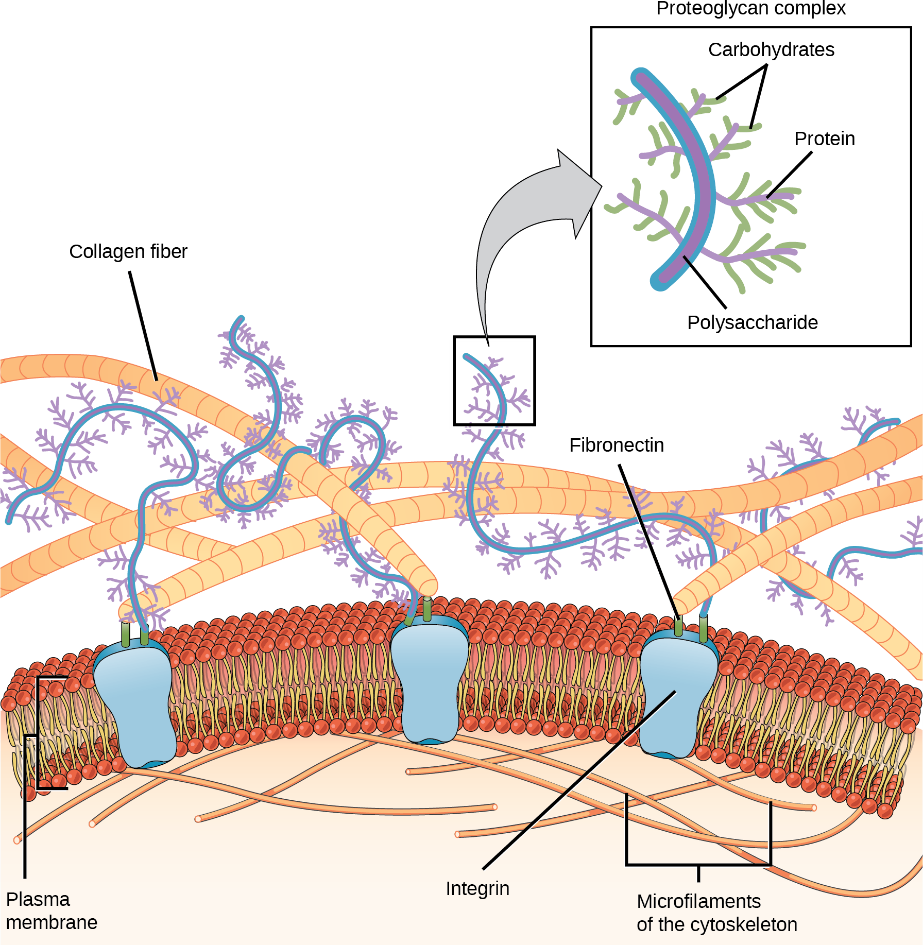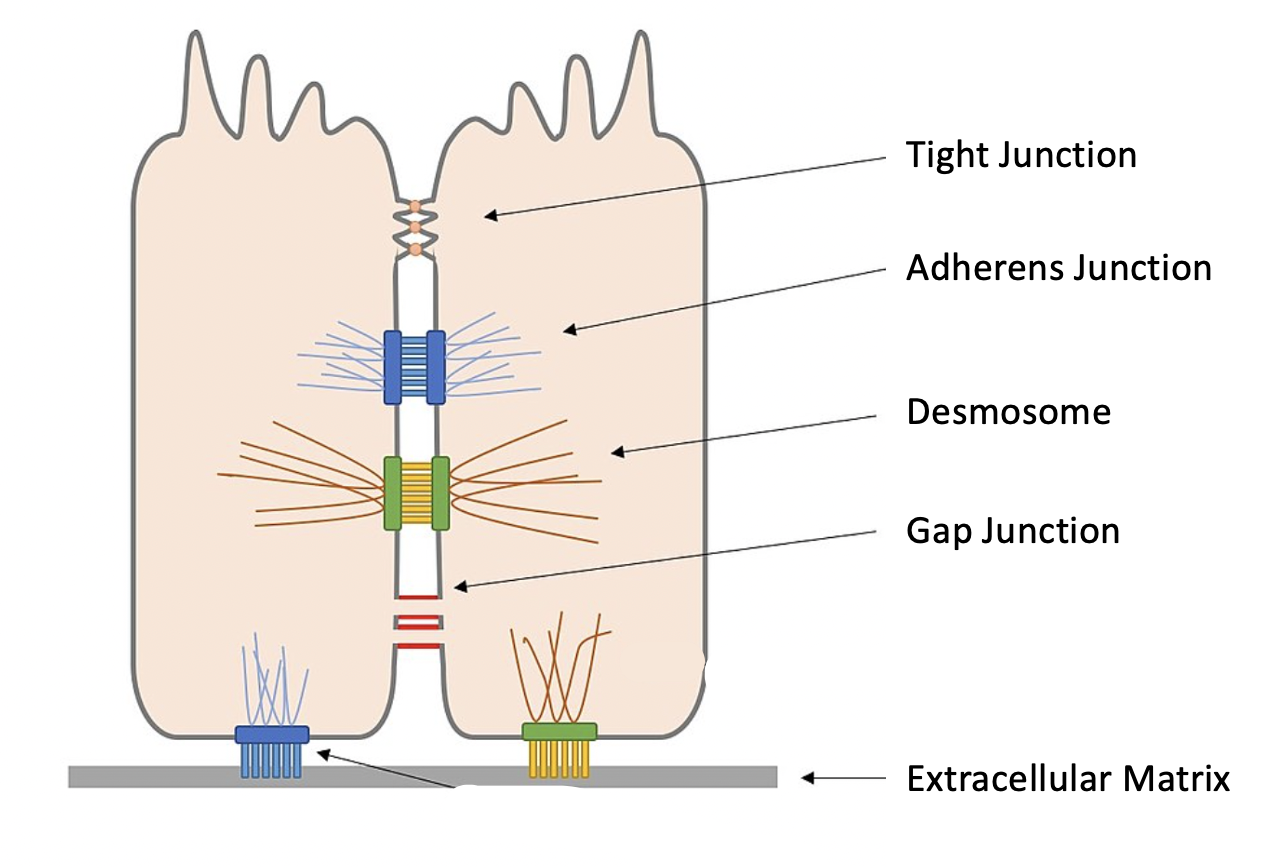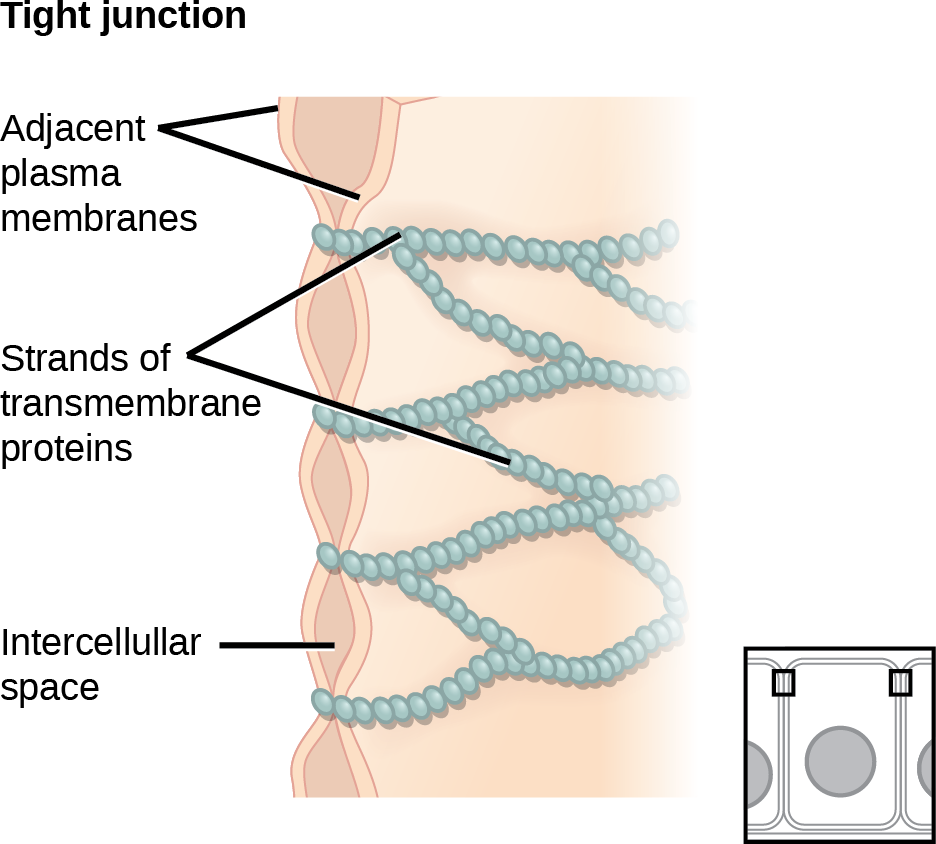4.6 Extracellular Structures and Cell-Cell Connections
KEY CONCEPTS
By the end of this section, you will be able to do the following:
- Recognize the structure and describe the functions of cell walls, extracellular matrices, and cell-cell connections
- List the important carbohydrates and/or proteins that are found in cell walls, extracellular matrices, and cell-cell connections
- Give examples of how the abundance or structure of cells walls, extracellular matrices, and cell-connections vary among different cell types
While the cytoskeleton provides lots of structural support, many cells are structurally supported by extracellular structures such as a cell wall. Even cells without a cell wall (e.g., animal cells) often have external supports. Some times these external supports are also important for helping cells stick to each other (e.g., in tissues) and communicate with each other, both of which are really important for multicellular organisms. In this chapter section, we will think about things outside of a cell – extracellular structures and neighbouring cells!
The Cell Wall
Have you ever noticed that when you bite into a raw vegetable, like celery, it crunches? That’s because you are tearing the celery cells’ rigid cell walls with your teeth. Most eukaryotic groups (plants, fungi and some protists) have a cell wall – a rigid extracellular structure that supports cell shape. You can see an example of cell wall location in the plant cell from Figure 4.3 in Chapter 4.1. The major organic molecule in the plant (and some protists’) cell wall is cellulose, a polysaccharide comprised of glucose units (Figure 4.30A). Cellulose in the plant cell wall provides mechanical strength and support. Chitin is the major structural component of fungal cell walls and helps anchor other components at the cell surface (Figure 4.30B). Cell walls usually also contain other molecules like lignin (e.g., in plant cell walls), other carbohydrates, and proteins.

Extracellular Matrix of Animal Cells
While animal cells do not have cell walls, they do have an extracellular matrix (ECM): a large network of proteins and other molecules outside the cell that surround, support, and give structural components to cells and tissues (Figure 4.31). The most common and abundant component in animal ECMs is collagen, a fibrous (long and “stringy”) protein. Collagen fibers are interwoven with proteoglycans, which are carbohydrate-containing protein molecules. There is also another fibrous called elastin, which has elastic properties. Various components of the ECM are attached to the cell surface by interacting with proteins that are embedded in the plasma membrane, like integrin. Fibronectin is one of the ECM proteins that connects to integrin. In animals, the ECM is most prominent in connective tissue (e.g., cartilage, ligaments, tendons), but each animal cell has some ECM.

Intercellular Junctions
In multicellular organisms, neighbouring cells often adhere, interact, and communicate through direct physical contact via specialized protein complexes (Figure 4.32). The types of cell junctions vary between animal, plant and fungal cells. For example, plant cells can have plasmodesmata, fungal cells can have septal pores, and animal cells can have tight junctions, gap junctions, adherens, and desmosomes (Table 4.2). Even within an organism, some types of cell junctions are more prominent in specific types of tissues. For example, tight junctions are abundant in animal epithelial cells (e.g., skin cells, cells lining the gut), while gap junctions are abundant in animal heart muscle cells. We will explore some of these specific cell junctions in the remainder of this section.

Table 4.2. Comparisons of different types of intercellular junctions.
|
Junction (analogy) |
Structure |
Function |
Location |
|
Plasmodesmata (channel) |
Channels between adjacent plant cells. Lined with plasma membrane. |
Allow transport of water, larger molecules like proteins and RNA. Helps coordinate growth and development. |
Between plant cells. |
|
Tight junctions (zipper) |
Watertight seal between two adjacent animal cells. Example protein: claudins. |
Prevents leakage of substances across the epithelial cell layer. Regulating flow of ions, water and other molecules. |
Lining of internal organs and cavities like urinary bladder. |
|
Gap junctions (channel) |
Protein-lined channels between adjacent animal cells. Example protein: connexins
|
Allows movement of ions, water, and small molecules between the cells. Important for cell-cell communication and helps in development of tissue. |
Between cardiac (heart) muscle cells.
|
|
Adherens and Desmosomes (buttons) |
Anchors cells to each other (extracellular component) and also to the cytoskeleton (intracellular component) Example proteins: cadherins
|
Mechanically linking cell together to form strong and stable tissues. Resist mechanical stress.
|
Heart muscle, bladder, gastrointestinal tract, skin. |
Plant Intercellular Junctions
In general, long stretches of the plasma membranes of neighboring plant cells cannot touch one another because of the cell wall that surrounds each cell. Plasmodesmata (singular = plasmodesma) are small channels that form small perforations in plant cell walls and directly connect the cytoplasm of neighbouring plant cells to each other (Figure 4.33). These plasmodesmata are roughly cylindrical, membrane-lined channels with a diameter ranging from 20 to 40 nm. Primary plasmodesmata form during cell division (when new cell wall is being created between two cells), while secondary plasmodesmata are inserted into existing cell walls. Numerous channels that pass between adjacent plant cell walls connect their cytoplasm, which enables the transport of materials (includes solutes, water and large molecules like proteins and RNA) from cell to cell, and thus throughout the plant.

Animal Intercellular Junctions
Animal cells adhere and interact with one another via four main junctions: tight junctions, gap junctions, adherens, and desmosomes. A tight junction is a watertight seal between two adjacent animal cells (Figure 4.34) that prevents small molecules from moving through the space between two adjacent cells. Tight junctions are also known as occluding junctions, and are mainly found in vertebrate animals. (Note that most invertebrate animals have a type of junction called septate junctions, which have a similar function but different structure from tight junctions.) Tight junctions are typically found in epithelial tissues that line internal organs, cavities and comprise most of the skin. For example, the tight junctions of the epithelial cells lining your urinary bladder prevent urine from the bladder (one side of the epithelium) to the space outside the bladder (the other side of the epithelum). Tight junctions also play a major role in maintaining blood-brain barrier of humans and other animals. [1]The blood-brain barrier is a highly complex and dynamic structure that is formed by endothelial cells that line the blood vessels adjacent to the central nervous system. The tight junction between endothelial cells serve to restrict blood-borne toxins and other dangerous substances from entering the brain.

Adherens and desmosomes act like spot welds (buttons) between adjacent animal cells (Figure 4.35). These two types of cell-cell connections both transmembrane proteins and the cytoskeleton. The transmembrane proteins in the plasma membrane are all part of a family of proteins called cadherins (a truncation of “calcium-dependent adhesion”). Cadherins from two adjacent cells bind to each other (extracellularly). Intracellular, cadherins connect to the cytoskeleton. The cadherins in desmosomes connect to intermediate filaments (e.g., filaments made of keratin; Figure 4.35), while the cadherins in adherens junctions connect to microfilaments . Connection to the cytoskeleton ensures that the desmosomes and adherens are anchored in place, which makes them a very strong connection point. Desmosomes are particularly strong, and often connect adjacent cells in organs and tissues that experience lots of stretch or mechanical strain, like the skin, heart, and muscles.

Gap junctions in animal cells fulfill a similar function to plasmodesmata in plant cells, but are lined with proteins rather than plasma membrane. These intercellular connections form channels between adjacent cells that allow for transporting ions, nutrients, and other small substances (Figure 4.36). Gap junctions develop when a set of six proteins (connexins) in the plasma membrane arrange themselves in an elongated donut-like configuration – a connexon. When the connexon’s pores (“doughnut holes”) in adjacent animal cells align, a channel between the two cells forms. Gap junctions are particularly important in cardiac (heart) muscle of many animals. The electrical signal for the muscle to contract passes efficiently through gap junctions, allowing the heart muscle cells to contract in a coordinated fashion.

- Sandoval, K.E., and Witt, K.A. 2008. Blood-brain barrier tight junction permeability and ischemic stroke. Neurobiol Dis 32(2): 200–219. doi:10.1016/j.nbd.2008.08.005. ↵

